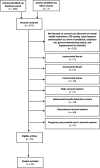Contraception need and available services among incarcerated women in the United States: a systematic review
- PMID: 32194976
- PMCID: PMC7077150
- DOI: 10.1186/s40834-020-00105-w
Contraception need and available services among incarcerated women in the United States: a systematic review
Abstract
Context: Seventy-five percent of incarcerated women are of reproductive age, most of whom are at-risk for unintended pregnancy. Women who are incarcerated come disproportionately from socioeconomically disadvantaged backgrounds and often lack access to desired reproductive health care. While the carceral system provides a unique opportunity to fill this gap, a better understanding of the contraceptive needs, desires, and plans of incarcerated women is needed to optimize health care provision within the carceral system. A review of current contraceptive services available to women inmates may both identify model care programs and shed light on areas for improvement.
Evidence acquisition: PubMed electronic database used to identify relevant articles published between January 1975 and September 2019 using a systematic review method.
Results: Twenty-five articles met the inclusion criteria and answered four key questions surrounding contraception in the carceral system. Most articles (48%) represented scientific research. Other publications identified by this review were expert commentaries, policy briefings, guidance and recommendations reports, and law and bioethics reviews.
Conclusions: Incarcerated women desire access to standard and emergency contraception from carceral health care systems. Knowledgeable family planning practitioners providing patient-centered and trauma-informed care and public health interventions linking newly released inmates to community clinics can help alleviate inmates' concerns regarding initiating desired contraception while incarcerated.
Keywords: Abortion; Contraception; Incarceration; Systematic review.
© The Author(s) 2020.
Conflict of interest statement
Competing interestsThe authors declare that they have no competing interests.
Figures
Similar articles
-
Canadian Contraception Consensus (Part 2 of 4).J Obstet Gynaecol Can. 2015 Nov;37(11):1033-9. doi: 10.1016/s1701-2163(16)30054-8. J Obstet Gynaecol Can. 2015. PMID: 26629725 English, French.
-
Canadian Contraception Consensus (Part 1 of 4).J Obstet Gynaecol Can. 2015 Oct;37(10):936-42. doi: 10.1016/s1701-2163(16)30033-0. J Obstet Gynaecol Can. 2015. PMID: 26606712 English, French.
-
Building an implementation framework to address unmet contraceptive care needs in a carceral setting: a systematic review.Health Justice. 2023 Oct 20;11(1):43. doi: 10.1186/s40352-023-00243-8. Health Justice. 2023. PMID: 37861888 Free PMC article.
-
Family planning services for incarcerated women: models for filling an unmet need.Int J Prison Health. 2017 Mar 13;13(1):10-18. doi: 10.1108/IJPH-07-2016-0025. Int J Prison Health. 2017. PMID: 28299966
-
Reproductive health and family planning needs among HIV-infected women in Sub-Saharan Africa.Curr HIV Res. 2013 Mar;11(2):160-8. doi: 10.2174/1570162x11311020008. Curr HIV Res. 2013. PMID: 23432491 Review.
Cited by
-
"We wish we had the option": a qualitative study of women's perspectives and experiences with contraception in a provincial prison in Ontario, Canada.Health Justice. 2024 Apr 12;12(1):15. doi: 10.1186/s40352-024-00269-6. Health Justice. 2024. PMID: 38607479 Free PMC article.
-
Jail as a Point of Contraceptive Care Access: Needs and Preferences Among Women in an Urban Jail.J Midwifery Womens Health. 2021 Nov;66(6):787-794. doi: 10.1111/jmwh.13270. Epub 2021 Aug 31. J Midwifery Womens Health. 2021. PMID: 34463421 Free PMC article.
-
Abortion and contraception for incarcerated people: A scoping review.PLoS One. 2023 Mar 30;18(3):e0281481. doi: 10.1371/journal.pone.0281481. eCollection 2023. PLoS One. 2023. PMID: 36996087 Free PMC article.
-
Contraceptive Needs Among Women Recently Incarcerated at a Rural Appalachian Jail.Womens Health Rep (New Rochelle). 2021 Jul 16;2(1):263-272. doi: 10.1089/whr.2021.0033. eCollection 2021. Womens Health Rep (New Rochelle). 2021. PMID: 34318296 Free PMC article.
-
Female permanent contraception policies and occurrence at a sample of U.S. prisons and jails.Contraception. 2021 Dec;104(6):618-622. doi: 10.1016/j.contraception.2021.08.005. Epub 2021 Aug 13. Contraception. 2021. PMID: 34400155 Free PMC article.
References
-
- Glaze LE, Kaeble D. Correctional Populations in the United States, 2015: Bureau of Justice Statistics; 2016. Contract No.: NCJ 250374.
-
- Kajstura A. Women’s mass incarceration: the whole pie 2018. Northhampton: Prison Policy Initiative; 2018.
-
- ACOG Committee on Health Care for Underserved Women Committee opinion 535: reproductive health care for incarcerated women and adolescent females. Obstet Gynecol. 2012;120(2 pt 1):425–429. - PubMed
-
- APHA . Task force on correctional health care standards. Standards for health Services in Correctional Institutions. Third ed. Washington DC: American Public Health Association; 2003.
Publication types
LinkOut - more resources
Full Text Sources
Miscellaneous


